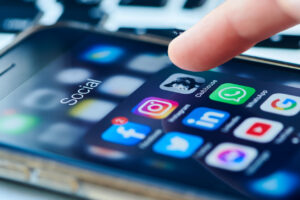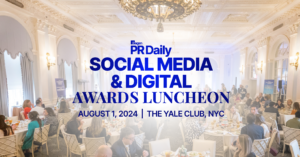Go from B2B to human-to-human for your next influencer program
The difference between B2B and B2C influencer marketing is smaller than you think.

There is no difference between B2B and B2C marketing when it comes to influencers. Why would there be? In the simplest of definitions, an influencer is someone who is persuasive and prominent in a specific niche and has an engaged audience who trusts them. So whether you’re enticing people to buy a mascara, encouraging them to see their doctor or selling a SaaS subscription, there’s always going to be an individual with clout (an influencer, if you will) that can do this better than a brand.
When we think of B2C, we think of fun, creative campaigns. When we think of B2HCP, we think of seriousness and regulation. And we often think of boring and basic when it comes to B2B, but it doesn’t have to be! We need to inject life into B2B marketing. In fact, let’s stop calling it that altogether. It’s just human-to-human marketing at the core, isn’t it?
For example, if you were a decision maker looking to purchase office supplies, would you go for the brand that sent you a one-page direct mail piece or would you go for the one that made you stop scrolling on your phone because a local artist was using the “basic” office pens to create a piece of art? I know which one I’d pick if I were the decision maker. Why? Because I’m human. These decision makers don’t just live and breathe their work, they also have other personal interests. And what’s more human than someone like-minded showing you the perks rather than a company telling them to you?
So what does that mean if you’re a brand that wants to market to other companies using influencers? Here are a few considerations to keep in mind:
- Put yourself in the decision maker’s shoes. Do you know what interests they have outside of work? What would excite them about the products that they’re selling?
- An influencer can take many forms. It can be someone with a small social media following as long as their audience is the exact niche you’re interested in. An influencer can also be someone who works for your company, or someone who works for one of your existing customers. Don’t forget the human aspect – it’s about the person’s story and connection to your brand, not how many likes they get on a post.
- Forget about social media for a second. Are there conferences your customers are likely to attend? Don’t just show up with an employee from your marketing department – bring a relevant influencer to the space to show not tell why your product works. Host an AMA and let them authentically connect with your potential customers or create an intimate event where they can get to use and understand your product in action.
OK, so these tips sound nice but how do you prove they work? Let’s talk about impact beyond impressions. One way to prove out how your influencer program impacts the brand is to create a brand lift study. A brand lift study typically uses two sample groups- – one with respondents who have seen your ad and one control group that has not. By comparing the two groups’ responses, you can determine the influencer’s contents’ direct impact on the KPIs and brand attributes that matter most — such as awareness, brand trust, relevance, believability, consideration, etc. Whatever the questions, you’ll be able to dig into what’s working, and what isn’t, when it comes to the content you’re asking your influencers to create.
You can go big with a Meta or Nielsen study, or there are plenty of smaller vendors that can do the same type of work. imre recently conducted a brand lift study that resulted in an 8-point statistically significant increase in net purchase intent proving the efficacy of our influencer program. These are the types of results you can use next time you go to your decision makers requesting funding for your influencer programs.
So don’t be the brand that can’t tap into your potential customers’ emotions and interests. Remember to think about your marketing in a human way, and the best way to do that is to employ other humans, Influencers, who can tell the story in the best way possible.
Masha Snitkovsky, is vice president of influencer marketing at imre.







This report is so good. A crucially important skill in PR is not just doing the work but getting management to approve it, and explanations like this win needed approvals. While some PR firms focus on getting budget, this one focuses on getting results.
With a firm like this, management can concentrate on managing the rest of the business and trust the PR experts to manage PR.